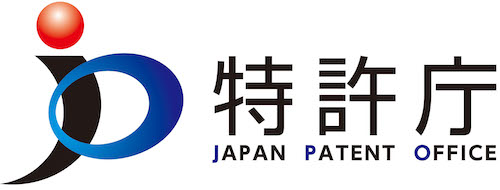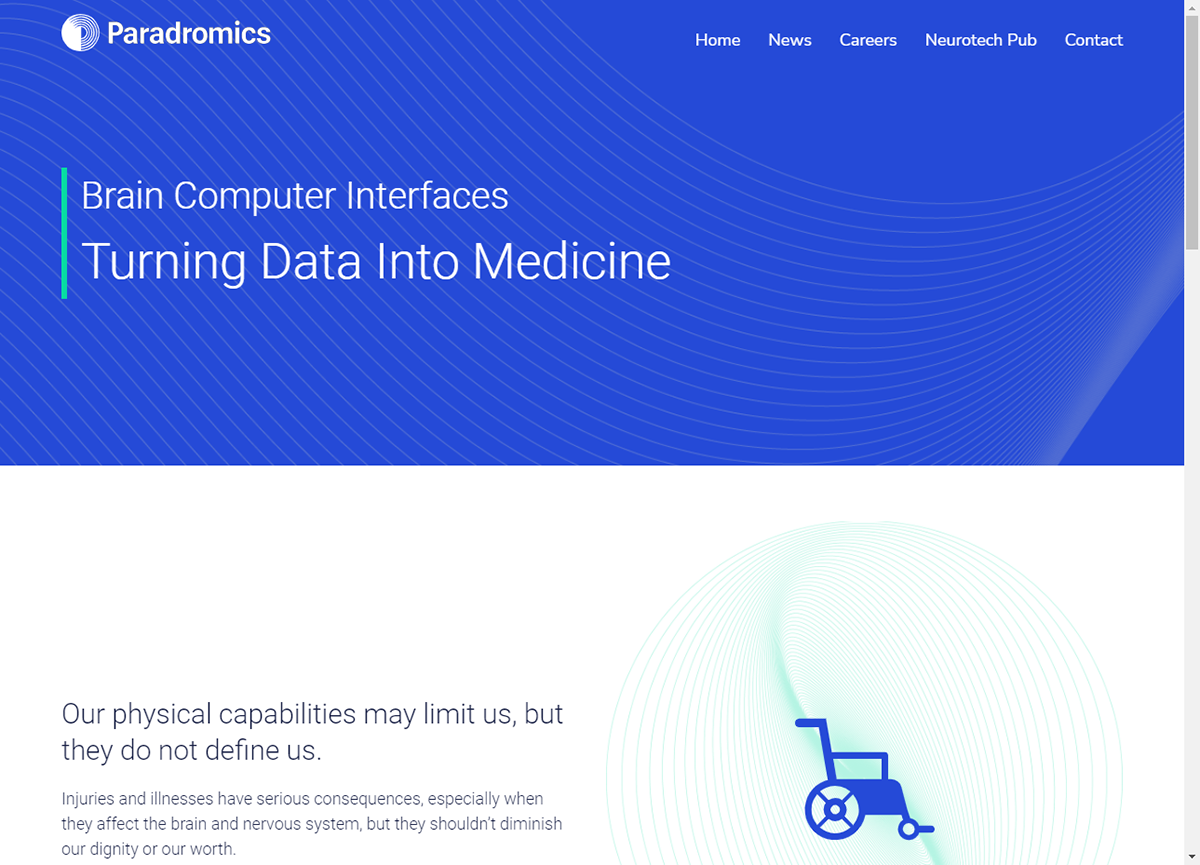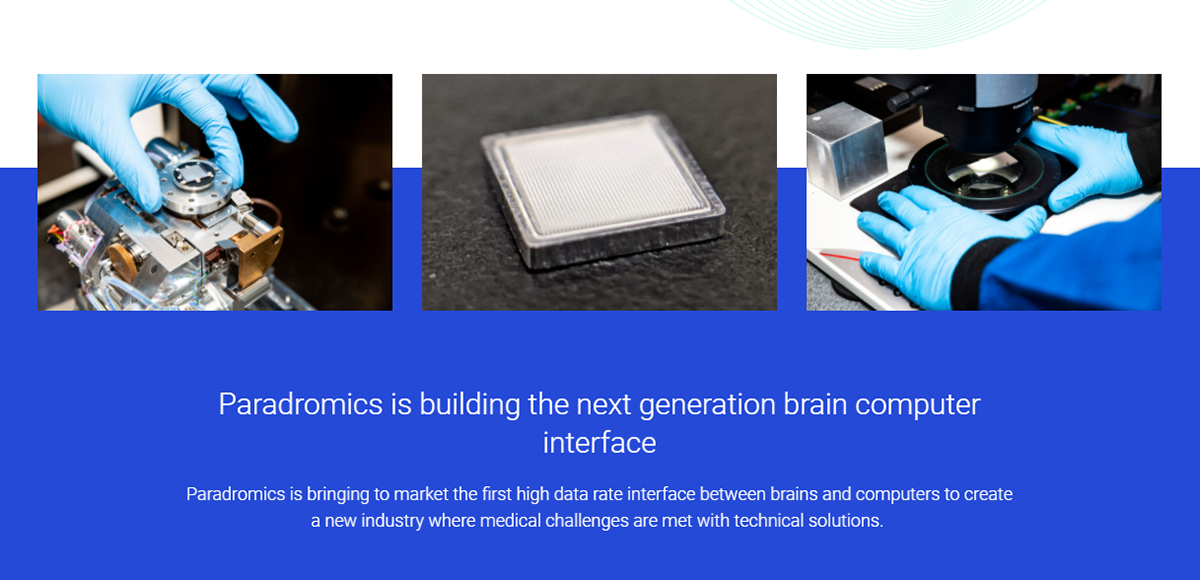IP BASE English Page
Paradromics 創業者兼CEO マット・アングル氏インタビュー/Interview with Paradromics CEO Matt Angle
革新的治療を実現、ブレインマシンインターフェースが開拓する医療の未来/Brain Machine Interface Opens the Future of Medicine for Innovative Treatments
脳とコンピューターをつなげることで、失われた身体機能を復活させて、精神疾患までも治療する。そんな未来を手元へと引き寄せる革新的なテクノロジーを研究開発するのが、米オースティンのスタートアップ・Paradromicsだ。医療装置の最先端を走る同社創業者CEOのマット・アングル氏に、最新テクノロジーについて、また特許に対する考え方やVCとの付き合い方、起業家の心得などを伺った。
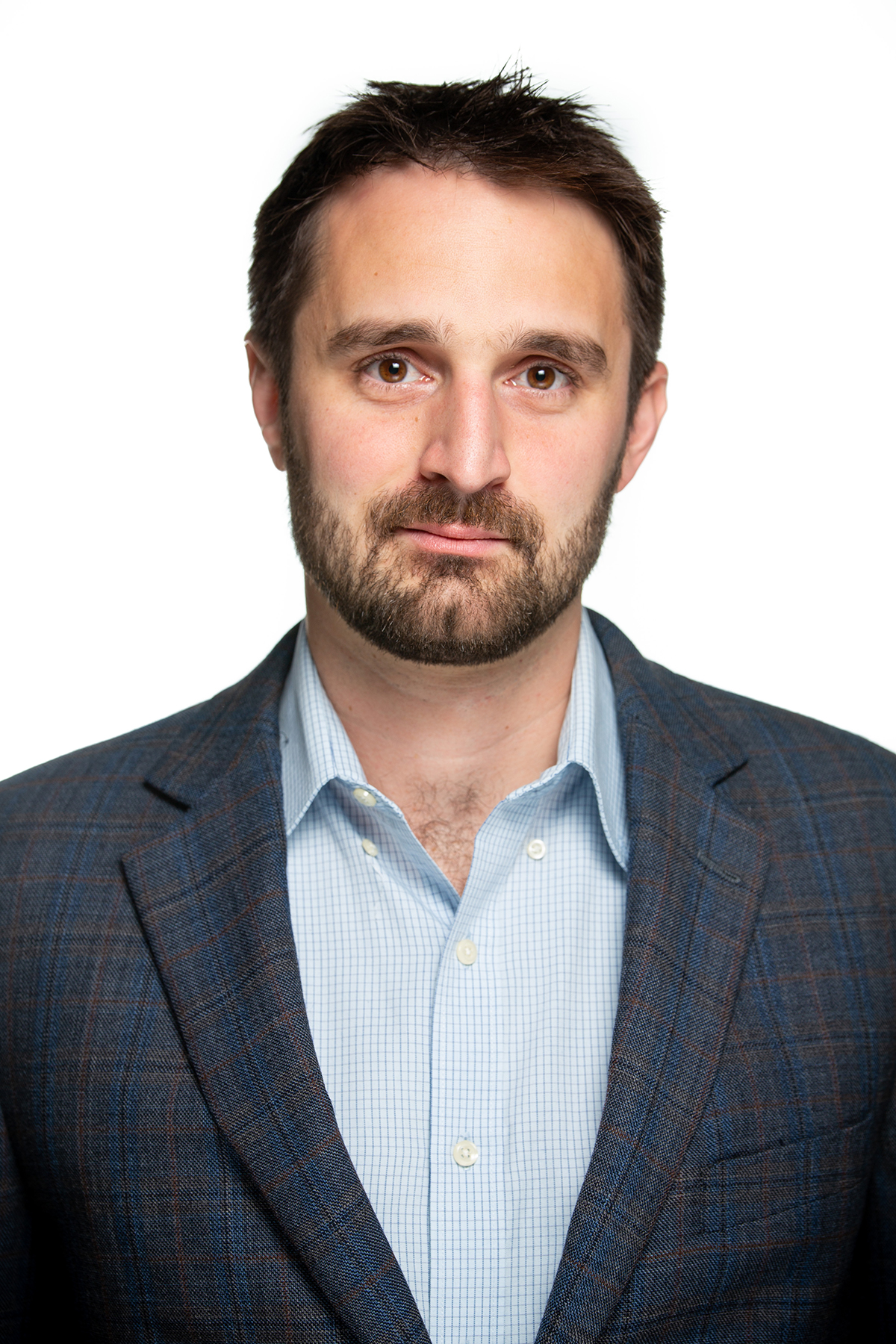
Paradromics 創業者兼CEO マット・アングル(Matt Angle)氏
Paradromicsの創業者兼CEO。神経科学およびニューロテクノロジーが専門。カーネギーメロン大学で生命科学を専攻。ハイデルベルク大学では神経科学博士号を取得。その後、スタンフォード大学にて材料工学およびエンジニアリング分野のポスドク研究員の際に次世代のニューラルエレクトロニクスに注力。2015年にParadromicsを創業した。
身体機能の回復や精神疾患の治療に役立つBMI/BCI
脳とマシン/コンピューターをつなぐ「BMI(Brain-Machine Interface:ブレインマシンインターフェイス)」もしくは「BCI(Brain Computer Interface:ブレインコンピューターインターフェイス)」の研究は1970年代には始まっていたが、現実味を帯びてきたのは2000年代に入ってからだろう。脳の活動を読み取り、電気信号(活動電位/神経インパルス)を介して脳に指令を送り込むことができれば、神経系の障害を補完して機能をサポートできる。
「これまで脳神経系の疾患から来る身体機能障害や精神疾患などは生体機能を治療するしかなかったが、それが技術で解決できるようになる。BCIは運動障害や感覚障害の治療に臨床試験で使用されており、初期の研究では、脳深部刺激はうつ病などの神経精神疾患の治療法として有望であることが示されている。弊社は、四肢麻痺の人のためのコミュニケーション・インターフェースを構築しており、将来的には精神疾患にも応用できる可能性があると期待している。障害や疾患は(ほかの人ができることをできないからと)恥じるものではなく、治療可能なものだと認識を変えていきたい」。Paradromicsの創業者でCEOのマット・アングル(Matt Angle)氏は熱く語る。
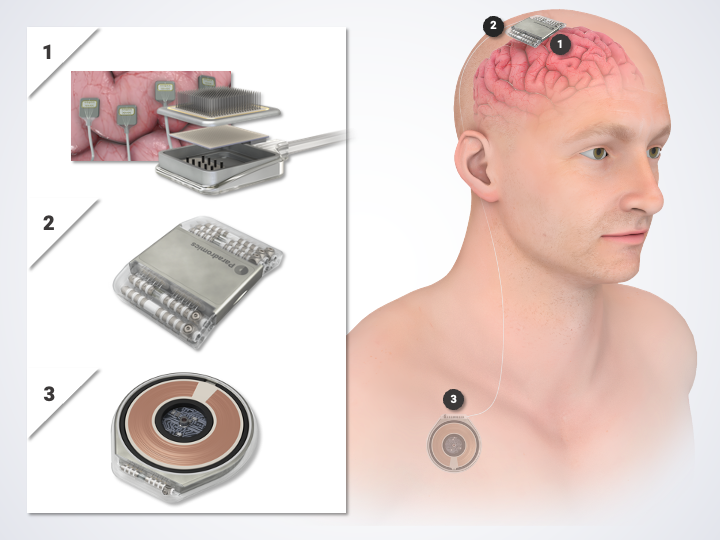
Paradromicsシステムの医療用途例。脳内で1600超ものニューロンからの信号を記録し(画像内1)、頭蓋をハブとして信号処理を完了(画像内2)、皮下の無線送信機(画像内3)が全体の電源と広帯域でのデータ処理を高いセキュリティのうえ行なう仕組みとなっている 画像提供:Paradromics
Paradromicsが開発するのは、神経インパルスを超高速で読み出し、書き出すことができる電極と回路だ。
私たち人間が何らかの感覚を知覚できるのは、神経細胞(ニューロン)が刺激を受けて生じる電位変化が神経インパルスとなって神経線維を伝わり、脳の感覚野へと送られるからだ。
体を動かす場合は、脳の運動野から筋肉へと神経インパルスが伝導して指令を伝える。この仕組みが事故や病気などの原因で壊れてしまい、“データ伝送”がうまくいかなくなると、視力障害や失語症、運動機能の低下といった症状が発生する。
Paradromicsが開発中の電極は、大脳皮質の表面直下にある個々の神経細胞からの信号を記録する。前例のない数の電極=神経細胞からのデータが収集され、これらは独自の電子回路で処理され、無線で送信される。ソフトウェアがデータを解析し、用途に応じて患者の意図する動作に変換される。
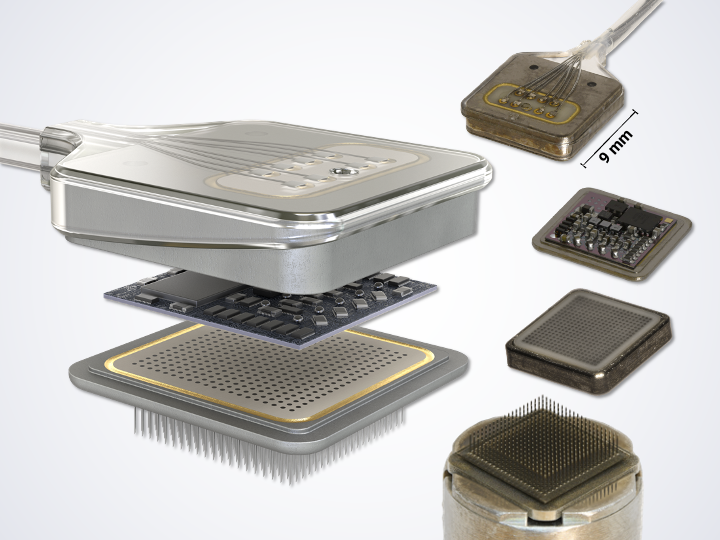
Paradromicsが開発する皮質に埋め込むモジュール 画像提供:Paradromics
「たとえば網膜や視神経の障害で視力を失った人であれば、高解像度カメラの画像データを視覚野に直接投影することで視力を回復させるといったことができるだろう。失語症であれば、声帯麻痺の患者向けの音声プロテーゼ装置(人工の発声医療器具)に実装できる。また、特定の脳機能を刺激して感情に作用を与えることが脳深部刺激療法(DBS)の初期臨床試験で確認されているが、神経精神疾患の治療にも使えるはずだ」(アングル氏)
治療用装置のイノベーションを目指すParadromics
Paradromicsのテクノロジーが既存のBMI/BCIと一線を画すのは、高速かつ広帯域でのデータ送受信が可能な点だ。
「現在多くのインプラント技術で使われているのはBlackrock Neurotechが約20年前に開発したUtah Arrayで、電極が100本のBMI/BCI第1世代。だが、たとえば視覚を回復したい場合、電極100本は少なすぎる。Paradromicsが開発した最初のシステムは、1600以上の電極実装している」(アングル氏)
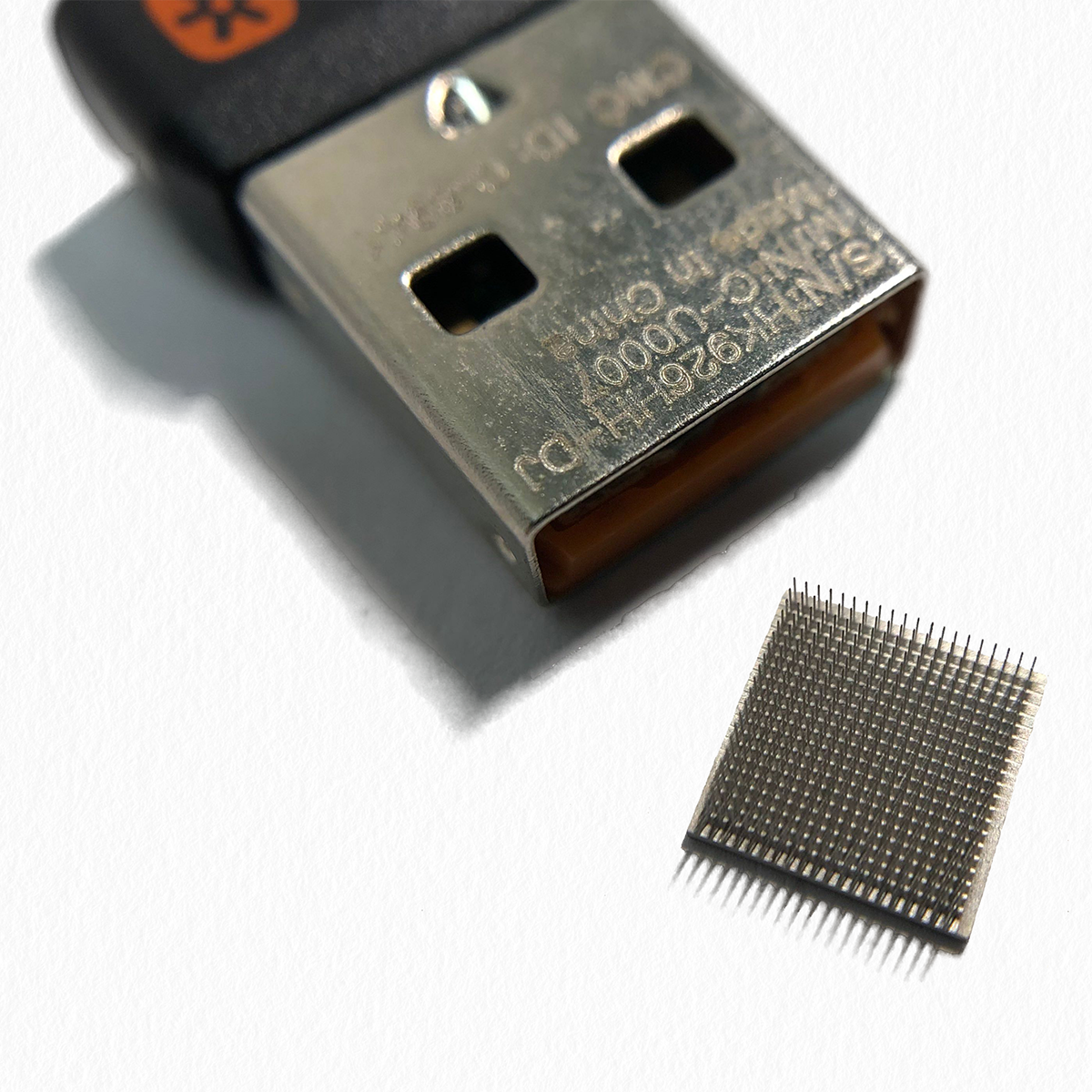
USBとサイズ比較した極小サイズのモジュールアレイ 画像提供:Paradromics
それでも、通常の視覚を再現するには少なすぎると述べるアングル氏は現在、通常の視覚の解像度を256x256ピクセルとした場合に相当する解像度を再現できるモジュールの開発に取り組んでいる。羊を使った前臨床試験で実証済みだそうだが、あくまで神経の信号から画像を出したのみであり、まだまだ小型化や帯域幅などの改善が必要だという
充電は、スマホのワイヤレス給電と同じ、誘導方式の電力伝送を採用している。皮膚を通して給電する最も効率的な方法だとアングル氏は説明する。
また価格についても、当初の適用対象は四肢麻痺で発声やキーボード入力ができないコミュニケーション問題があるようなアンメット・メディカル・ニーズ(治療法がまだ見つかっていない疾患における医療ニーズ)となる算段が非常に高く、償還もあってデバイスの価格をあまり気にしない層が提供先になることから、高額になるとアングル氏。例えばパーキンソン病や手や頭に震えが生じる本態性振戦などの神経刺激装置に対する償還は、デバイスあたり2万ドルから3万ドルあたりであることから、価格帯はなんとなく推測できるだろう。
アングル氏は、Paradromicsのテクノロジーはスマホのように誰もが手にできるものだと投資家によく勘違いされると明かす。引き合いに出されるイーロン・マスク氏のNeuralinkが目指すのは、安価で使い捨てるタイプのデバイスだ。数年おきに買い替えるので、耐久性はそれほど重要ではない。
一方のParadromicsは治療用装置のイノベーションが目的で、体内に10年程度埋め込むことを想定した耐久性の高いインプラントでの採用が主流となる。「治療のためであっても、脳外科手術はそもそも実施しないことが理想的。重篤な病状がある場合でも、誰でも1回のみにしたいはず」(アングル氏)
10年間の耐久性を実現するために、浸水しない超密閉ボックス、耐久性に優れた白金やロジウムのマイクロワイヤーなど、十分な時間をかけて素材や仕組みの検討を行ったと話すアングル氏。「ペースメーカーやDBSプローブの医療機器メーカーは多々存在するが、上記のような信頼性や高品質なデータレートを満たせるデバイスを作れるのは、Paradromicsだけだ」
特許は守りを固めるためのものにあらず
画期的なテクノロジーを持つParadromicsは、特許についてどう考えているのだろうか。
特許には2つのアプローチがあるとアングル氏は言う。1つは、自社テクノロジーを守るための道具だ。ただし、やや攻撃的な使われ方がされることに同氏は懸念を示す。
「古い製薬会社などを見ていると、自社テクノロジーが侵害されないよう、何人たりとも越えられないような深い壕で周囲を囲み、関連特許を次々と申請して競合他社の動きを封じ込めようと躍起になっている」。
それはまるで、実力がありながら陰で策略を練り、ライバルの妨害を繰り返すWacky Races(『チキチキマシン猛レース』)のブラック魔王のようだと同氏は揶揄する。
もう1つは、ビジネスの機敏性を高めるツールというアプローチだ。その好例として、アングル氏はイーロン・マスク氏を挙げる。なお、NeuralinkよりParadromicsの方が設立は早く、アプローチも異なることは付記しておく。
「SpaceXやTeslaなど、マスク氏は誰よりも速くアイデアを実行する。しかも、ブラック魔王のような妨害工作はせず、常にイノベーションを繰り返しながら最先端を走り続けている。当然、彼のビジネスを真似する企業も出てくるが、誰も彼に追いつけないので燃えカスを拾うしかない」(アングル氏)
特許などの知的財産には多大な価値があり、ターゲットとする領域で自由にビジネスするための力となる。また、小さなスタートアップが老舗の大手企業と対等に渡り合うための切り札にもなる。しかし、どんなに素晴らしい特許でも、それをどんなに大量に抱え込んでいても、革新的な事業計画やスピード感のある行動力・実行力に勝るものはないと、アングル氏は断言する。
「Paradromicsも特許を取得しているが、最高の製品をいち早く提供するのが目的。最高のものを誰よりも先んじて市場に投入できるということを証明するためのツールだ」(アングル氏)
特許のライセンシングについても、複雑なテクノロジーのため誰それ構わずにライセンス提供できるわけではないと断りつつ、「私たちのテクノロジーは何かを実現するための機能のひとつで、医療業界のエコシステムの一部。さまざまな神経治療で役立ててもらえるようなパートナーシップは積極的に組んでいきたい」と述べた。
VCは資金面でのみ選ぶか、それとも長期的関係を視野に選ぶべきか
スタートアップが事業を拡大する中で、もう一つ重要な要素となるのがVC選びだ。起業当初はNIH(米国国立衛生研究所)やDARPA(国防高等研究計画局)から助成金を得て研究開発していたが、VCとの交渉も並行して進めていた。そして2021年7月には、シードラウンドでPrime Movers Labから2800万ドルの資金調達に成功している。
数々のVCとミーティングを繰り返してきたアングル氏。VC選びのポイントは、「未来の起業家にとって重要なことは、資金提供してくれる可能性の高いVCと話をすること。特に、投資決定権のある人と話をすることだ」と助言する。
特にブレインマシンインターフェイスは今注目の分野だけに、とりあえずミーティングしておこうという冷やかしも多く集まってきた。「自分たちの事業領域を理解し、適切な投資計画を立ててくれるのはどこかを、早い段階で見極めていくことが大切だ。資金面だけでVCを判断することも可能だが、適当な相手だとタームシートがゴミくずになることもある。長期的な関係性も視野に入れながら、どのVCと付き合うか判断したい」(アングル氏)
成功も失敗も、何らかの形でその成果が社会に還元される
最後に、起業を目指す人たちへのアドバイスを伺ったところ、「失敗を恐れず挑戦すること」とアングル氏は述べた。
同氏はドイツで4年間、学生時代を過ごしたとき、起業に対する考え方が米国のそれとは異なり、やや閉鎖的であることを知ったという。
アングル氏は米国人の良い点を、ともすれば傲慢なほど自分に自信があり、失敗を恐れないところと指摘する。「何か大きな賭けをして挑戦する人はすごい。成功しても失敗しても、何らかの形でその成果が社会に還元される」(アングル氏)
だからこそ、起業家には失敗を恐れず、一歩前に踏み出してほしいとアングル氏は言う。そして、誰かが何かに挑戦するときは、「どうせ失敗するに決まっている」「失敗したら恥ずかしい」と言って突き放すことをしないでほしいと訴える。
「失敗したくない気持ちは、常に正解を当てたい研究者の性としてもよく分かる」と笑うアングル氏。実際、同氏も失敗がよぎって起業しようかどうか迷った時期があった。だがそんなとき、「考えすぎだ。失敗しても後悔なんてする必要はない。まずは挑戦してみろ」と背中を押してくれた友人たちがいたという。
失敗を怖がらないこと。そして、挑戦しようとする人たちを結果がどうなろうとも、力いっぱい応援して支えてあげること。そんな起業家精神を胸に、未来に挑んでほしいと、アングル氏はエールを送ってくれた。
Connecting the brain with a computer could restore lost bodily functions and even treat mental illness. Paradromics is one Austin-based startup researching and developing innovative technologies that hope to bring about such a future to our hands. We spoke with Matt Angle, the CEO of the cutting-edge medical device company, about the state of the latest technology, dealing with patents, working with VCs, and what it takes to be an entrepreneur.

CEO of Paradromics, Matt Angle. Specialized in neuroscience and neurotechnology, he holds a B.S. in Life Sciences from Carnegie Mellon University and a doctorate of Neuroscience from the University of Heidelberg. Prior to founding Paradromics in 2015, Angle worked as a postdoctoral researcher in material science and engineering at Stanford University focused on next-generation electronics for neural recording.
BMI/BCI for the Recovery of Physical Capability and Mental Illness
Connecting the brain with machines/computers (BMI: Brain-Machine Interface / BCI Brain Computer Interface) initially began research in the 1970s but it wasn’t until the 2000s that the concept started to become a reality. If it is possible to read brain activity and send commands directly to the brain via electric signals (action potentials/neural impulses), they can be used to aid nervous system disorders and directly assist in their functioning.
“Until now, the only way to treat physical and mental dysfunction was to target the biological processes that cause these diseases of the brain and nervous system. This may soon be solved with technology; BCIs are being used in clinical trials for treatments of motor and sensory disorders, and early research indicates that deep brain stimulation has promising evidence as a potential treatment for neuropsychiatric disorders such as depression. Paradromics are building a communications interface for people who are paralyzed, and we expect future applications to possibly include mental illness. We hope to reframe the perception of disabilities and diseases to further destigmatize them, instead, offering them something objective that can be treated.” Stated Matt Angle, CEO of Paradromics.

Medical application example of the Paradromics system. Signals from over 1600 individual neurons are recorded (1), signal processing is completed by the cranial hub (2), and the subcutaneous wireless transmitter (3) provides the system power and a high-security, high-bandwidth data relay.
Image credit: Paradromics
Paradromics is researching and developing electrodes and circuits that are able to read and write nerve impulses at a very high speed.
We, humans, are able to perceive sensations through the stimulation of nerve cells, which causes a change in electrical potential and gets transmitted throughout the nerve fibers. These impulses then reach the sensory cortex of the brain.
Similarly, when moving our bodies, nerve impulses are sent from the motor cortex of the brain down to the muscles that the command conveys. If this process is interrupted due to an accident or illness and the “data-transfer” is hampered, it can lead to disorders with symptoms such as visual impairment, aphasia, loss of motor function, etc.
The components being developed by Paradromics record signals from individual neurons just below the surface of the cortical brain. Data is gathered from an unprecedented number of electrodes and, thus, an unprecedented number of individual neurons. Proprietary onboard electronics process the signals, which are transmitted wirelessly. Software analyzes the data and translates it into the patient’s intended action, depending on the application.

The Paradromics-developed embedded module for the cortex.
Image credit: Paradromics
“For instance, people who have lost their sight due to retinal or optic nerve damage could have images projected directly into the visual cortex with a high-resolution camera. There are also clinical trials around the world looking in the reverse direction. For example, paralyzed patients neurologically demonstrate the intent to speak, but the signal processing cannot transmit into physical movement. These disrupted signals are intercepted by implants, and the data is used to type text or move a cursor on a screen. In addition, other clinical trials use Deep Brain Stimulation (DBS) where stimulation of certain areas of the brain can affect things such as mood or even neuropsychiatric illnesses.” - Angle.
Paradromics Aims for Innovation in Therapeutic Devices
What sets Paradromics’ technology apart from other BMI/BCI solutions is its potential for massive amounts of highly parallel transmission of data, allowing for high speed and large data transfer directly from the neural sources.
“The most common implant technology in use today was developed 20 years ago, called the Utah Array. This first-generation BMI/BCI technology holds approximately 100 electrodes. However, if you want to restore something complex such as vision, 100 electrodes are far too few. The first system developed by Paradromics supports over 1600 electrodes.” Mr. Angle

Size comparison of the ultra-small module array with a USB.
Image credit: Paradromics
In addition to this, vision replication is also being researched. When discussing what is achievable with these kinds of platforms, Angle gave the example of a 256 x 256-pixel visual interface: while it is currently not suitable for restoring vision capability, they have been able to create recording-capable modules with this resolution. Trials on sheep have shown success using these modules to build a digital representation of their vision. Further work is necessary for miniaturization and improvement of bandwidth capabilities.
As for charging, much like a smartphone wireless charging solution, they use induction for power transmission. This is the most efficient way to transmit energy through the skin, Angle explained.
Looking at the price, it is not expected to be cheap. It would first be used in medical treatments such as targeting severe tetraplegia, due to their unmet medical needs (i.e., diseases with no current cures available). These individuals have lost the ability to speak and type, Paradromics’ first indication will aim to regain the ability to communicate. Treatment for these diseases comes at a high cost, and with the aid of reimbursement schemes, the target market is unlikely to worry about the price, Angle stated. Currently available brain devices for diseases such as Parkinson’s, for example, can cost tens of thousands of dollars per device.
Angle revealed that Paradromics' technology can often be mistaken by investors as a product for a wide target market that everyone can own, similar to the smartphone. This is what is cited as the goal of the Neuralink, a device being developed by Elon Musk - an inexpensive, disposable device. As those devices are meant to be replaced every few years, durability is less important.
On the other hand, Paradromics’s goal is innovation in therapeutic devices. These devices need high durability as they are expected to be implanted into the body for about ten years when they become mainstream."The ideal number of neurosurgeries someone can undergo is zero and if you have a serious medical condition the next best number is one.”-Angle
To achieve this durability of a 10-year lifespan, Angle spent plenty of time investigating the most suitable materials to construct it with, such as the implant needing to be in a waterproof housing and using ultra-durable platinum and rhodium microwire. “There are a lot of medical device manufacturers that produce devices such as pacemakers, or DBS probes, but at present, only Paradromics is seeking to achieve that level of robustness and reliability for high data rate BCI.”
Patents: Not Just for Protection
What does Paradromics, a company with such groundbreaking technology, think about patents?
Angle says that there are two approaches to patents. Firstly, a tool to protect your technology. However, he indicates concern when using them in a somewhat aggressive manner.
“If you look at old pharmaceutical companies, to ensure their technology isn’t compromised, they file a series of related patents to ensure that they keep their competitors at bay, essentially surrounding your property with a ‘deep moat’.”
Angle likened it to Dick Dastardly from Wacky Races, a powerful man, but always scheming in the background, sabotaging his rivals.
The other approach [to patents] is to use them as a tool to increase business agility. Angle cited Elon Musk as being effective at this. It should be noted that Paradromics actually precedes Neuralink and also takes a very different approach in their technology.
“With Elon Musk’s other ventures, such as Tesla & SpaceX, he executes his ideas faster than anyone else. What’s more, he doesn’t sabotage others like Dick Dastardly; his companies constantly innovate to stay on the cutting edge. Naturally, many will try to copy his business(es), but no one will be able to keep up with him - so they end up eating his exhaust fumes” - Mr. Angle.
Intellectual property, such as patents, has tremendous value and can empower your business to operate freely in areas you target. It can also be a trump card for those small startups to compete on equal terms with well-established companies. Despite this, Angle insisted that no matter how great a patent is, nor how many you have registered, nothing will beat an innovative business plan and the capability to execute the said plan with speed.
“Paradromics also acquires patents, but the primary goal is to be first to market with the best products. It is an important tool to show that we can bring the best to market before anyone else.” - Angle
As for patent licensing, due to the complexity of the technology, they do not just license the technology out to anyone. “There is one main feature of what we implement with our technology and is part of the medical industry. We are very interested in forming partnerships with companies that will help us with a variety of neurological treatments,” he stated.
Choosing a VC: Favor Financial Strength or Long-Term Relationship Potential?
As startups expand their business, another important factor to consider is their choice of a VC. In the early days of the company, they received grants from NIH (National Institutes of Health) and DARPA for research and development, but VC negotiations were happening concurrently. Then, in July of 2021, the company received a 28 Million dollar investment from Prime Movers Lab in their first round of seed funding.
Angle had numerous meetings with different VCs. When searching for a VC, “it’s important for future entrepreneurs to look at and speak with VCs that are likely to fund you. Specifically, speak to the people that have the authority to make investment decisions.”
In particular, brain-machine interfaces are a very hot field right now, so there were a lot of window shoppers setting up meetings just to learn more, despite having no background. “It is important to understand at an early stage who understands our business and can make an appropriate investment plan. It is possible to judge a VC on funding alone, but with the right partner, term sheets can even become a waste. A suitable partner has long-term staying power. I want to decide which VC I want to be associated with while considering them as a potential long-term partner” - Angle.
Success or Failure, Both Outcomes Return to Society in Some Form
Finally, when asked to give advice to budding entrepreneurs looking to start a business, Angle insisted to “not be afraid of failure.”
Germany, he found that attitudes towards entrepreneurship were vastly different to those in the US, they were somewhat closed he stated.
According to Angle, Americans have the benefit of being self-confident, to the point of arrogance, meaning they are not afraid of failing. “It’s amazing how people will take a chance on something big. Whether you succeed or fail, your results will be returned to society in some way.” - Angle.
As such, Matt Angle implores entrepreneurs to take the leap forward without the fear of failure. Also, if someone tries taking on the challenge he urges them to avoid thinking that they “will fail anyway,” or “it’s embarrassing to fail.”
“As a researcher who always wants to get the right answer, I can understand the feeling of not wanting to fail,” Angle laughs. In fact, there was once a time when he felt unsure about starting his own business due to his previous failures. When he felt like this, he would be reassured by his friends, “You’re thinking too much, even if you fail there is no need to regret your mistakes. Just try!”
No matter the outcome, support those who take on challenges with all their might. With this entrepreneurial spirit, Matt Angle encourages us all to take on more challenges in the future.
